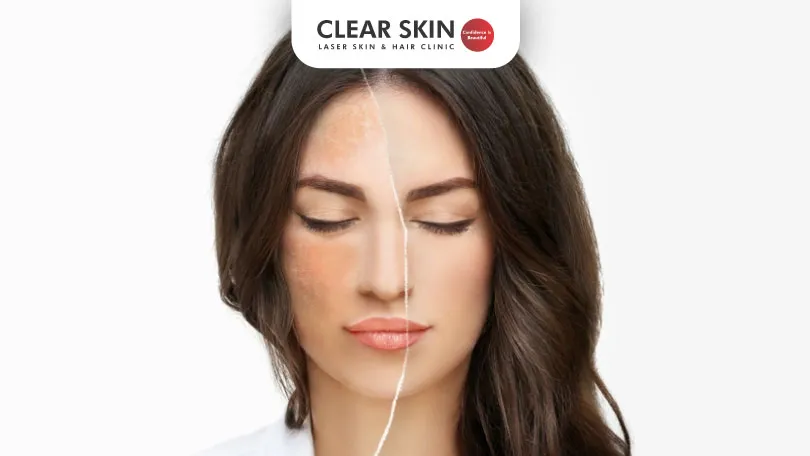Unlocking the Mystery of Mandibular Melasma and Centrofacial Melasma
Reviewed By: ![]() Dr. Dhananjay Chavan
Dr. Dhananjay Chavan
Updated on: 28th December, 2023

In this article, we will explore the causes, symptoms, and treatment options for mandibular and centrofacial melasma, helping you unlock the mystery of this frustrating skin condition.
Have you ever noticed brown or grey patches on your cheeks, nose, or chin that won’t go away no matter what you do? Do they worsen when exposed to the sun or hormonal changes? If so, you may be suffering from mandibular or centrofacial melasma.
Melasma is a common skin condition that affects many people, especially women. It is characterised by dark, irregularly shaped patches on the face and is caused by the overproduction of melanin in the skin. While melasma can occur anywhere on the face, it is particularly common on the jawline and chin (mandibular melasma) or the cheeks and forehead (centrofacial melasma).
The exact causes of melasma are still unknown, but several factors may contribute to its development, including genetics, hormonal changes, and sun exposure.
Table Of Content
- Mandibular Melasma
- Centrofacial Melasma
- Conclusion
Mandibular Melasma
Melasma on the mandibular area is not a separate or distinct type of melasma but rather a location where melasma can occur. The mandibular area is the lower part of the jaw, extending from the chin to the corners of the mouth and up to the jawline.
Melasma on the mandibular area can appear as brown or grey-brown patches on the skin, usually on both sides of the lower jaw. The patches may extend from the chin to the ears or neck. The distribution of melasma on the mandibular area can vary from person to person, but it typically affects the cheeks, chin, and jawline. Melasma on the mandibular area is not a separate or distinct type of melasma but rather a location where melasma can occur.
Mandibular melasma can occur in both men and women, but it is more common in women, particularly during pregnancy or while taking birth control pills.
The exact causes of mandibular melasma are not known. However, it is thought to be related to hormonal changes, genetics, and sun exposure.
Ultraviolet (UV) rays from the sun stimulate the production of melanin, many times sun exposure is the commonest trigger that causes melasma on the face, including mandibular area
In women, hormonal changes during pregnancy, birth control pills, or hormone replacement therapy can trigger melasma in the mandibular area. In addition, genetics may play a role, as melasma tends to run in families.
Other factors that may contribute to the development of melasma in the mandibular area include inflammation and stress. Inflammation can trigger melanin production, while stress can disrupt the normal hormonal balance in the body.
Treatment for mandibular melasma is similar to that for other types of melasma. It involves a combination of topical medications, such as hydroquinone, retinoids, and depigmenting agents, as well as procedures, such as chemical peels or laser therapy.
Sun protection is also crucial in preventing the worsening of melasma, so it is important to use broad-spectrum sunscreen with an SPF of at least 30, wear protective clothing and hats, and avoid direct sunlight during peak hours.
It is also recommended to avoid smoking and limit alcohol intake, as these habits can worsen the condition. Consultation with a dermatologist is recommended for a proper diagnosis and treatment plan.
Centrofacial Melasma
The term “centrofacial” refers to the central part of the face, where the patches tend to appear. Centrofacial melasma is a type of melasma that is characterised by the appearance of brown or greyish-brown patches on the central part of the face, including the forehead, cheeks, nose, upper lip, and chin.
Like other forms of melasma, centrofacial melasma is caused by a combination of factors, including hormonal changes, sun exposure, genetic predisposition, and certain medications. It is most common in women, particularly those with darker skin tones, and is often associated with pregnancy or oral contraceptives.
Centrofacial melasma treatment in Pune involves a combination of topical medications, such as hydroquinone, retinoids, and depigmenting agents, as well as procedures, such as chemical peels or laser therapy. Sun protection is also essential in preventing the worsening of melasma, so use broad-spectrum sunscreen with an SPF of at least 30, wear protective clothing and hats, and avoid direct sunlight during peak hours.
It is also recommended to avoid smoking and limit alcohol intake, as these habits can worsen the condition. Consultation with a dermatologist is recommended for a proper diagnosis and melasma treatment in Pune.
Do You Know?
Roughly 250 Patients Are Treated
Everyday By These Dermatologists
(You are one click away from flawless skin)
Meet Our Dermatologist!
Conclusion
Melasma is a common skin condition that various factors can trigger, including genetics, hormonal changes, sun exposure, and certain medications. Mandibular melasma and centrofacial melasma are two types of melasma that affect different face areas.
If you’re dealing with mandibular melasma, centrofacial melasma, or any other skin concerns, Clear Skin Clinics Pune is here to help. With a team of experienced dermatologists and cutting-edge technology, we can help you achieve clear, healthy, and radiant skin.
Don’t let melasma or any other skin condition hold you back from feeling confident and beautiful in your skin. Contact Clear Skin Clinics Pune today and start your journey to clearer, healthier skin.
Further Reading
How to Avoid Acne in Monsoons?
Avoid acne in monsoons with a gentle skincare routine, diet tips, and hydration. Get expert advice to manage breakouts and keep your skin clear and healthy.
Does Makeup Cause Acne-Prone Skin?
Worried about breakouts from using makeup? Does makeup cause acne for you? Learn the safe ways to apply makeup for acne-prone skin.
Morning Skin Care Routine for Glowing Skin
Clear Skin Clinic, led by top dermatologists, shares the ideal morning skincare routine to help you achieve a radiant complexion naturally and effectively.
Monsoon Skin Care Tips for Radiant, Healthy Skin
Clear Skin Clinic, led by top dermatologists, shares the ideal morning skincare routine to help you achieve a radiant complexion naturally and effectively.
Have thoughts? Please let us know
We are committed not only to treating you, but also educating you.





